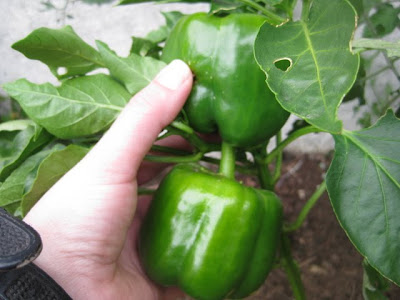 I'm not sure why, but growing tomatoes is probably the highlight of having a vegetable garden. Maybe it's because I am trying to accomplish something that never does that well in the cool Pacific Northwest and so any success is a victory for me. The picture above show some green cherry tomatoes from last year's garden (2010).
I'm not sure why, but growing tomatoes is probably the highlight of having a vegetable garden. Maybe it's because I am trying to accomplish something that never does that well in the cool Pacific Northwest and so any success is a victory for me. The picture above show some green cherry tomatoes from last year's garden (2010). Earlier this year on a very warm January Saturday, I was able to weed the section of my raised vegetable garden bed pictured above and cover it up with plastic. The large river rocks came in handy as anchors to keep the plastic from flying away in the wind. I am also planning on planting the peppers in this same bed along with the tomatoes. As most gardeners have learned, black plastic mulch will raise the soil temperature by absorbing the heat. The added bonus is that it also keeps the weeds from growing back in the cleared bed. This plastic was given to me by a neighbor who works for one of the mills here in Grays Harbor county and I have discovered that it is a woven material that actually allows water to pass through it. This is a great advantage and answered my question as to why the puddles that collected on the surface disappeared so quickly!
Earlier this year on a very warm January Saturday, I was able to weed the section of my raised vegetable garden bed pictured above and cover it up with plastic. The large river rocks came in handy as anchors to keep the plastic from flying away in the wind. I am also planning on planting the peppers in this same bed along with the tomatoes. As most gardeners have learned, black plastic mulch will raise the soil temperature by absorbing the heat. The added bonus is that it also keeps the weeds from growing back in the cleared bed. This plastic was given to me by a neighbor who works for one of the mills here in Grays Harbor county and I have discovered that it is a woven material that actually allows water to pass through it. This is a great advantage and answered my question as to why the puddles that collected on the surface disappeared so quickly! Last week, after planting the pepper seed, I potted up each of the tomato plants. Since they were started in Jiffy peat pots, all I had to do was place each plant, Jiffy and all, into the new pot and fill it with soil. I always fill the pots with as much soil as possible. This not only allows maximum root expansion but also encourages rooting along the stem of each plant. These root stems create a more vigorous plant which is something every one wants.
Last week, after planting the pepper seed, I potted up each of the tomato plants. Since they were started in Jiffy peat pots, all I had to do was place each plant, Jiffy and all, into the new pot and fill it with soil. I always fill the pots with as much soil as possible. This not only allows maximum root expansion but also encourages rooting along the stem of each plant. These root stems create a more vigorous plant which is something every one wants. Here are the newly potted up tomatoes put back under the grow light.
Here are the newly potted up tomatoes put back under the grow light.  Here they are 6 days later. Notice how much they have grown! All plants have greened up nicely and if I remove some of the soil that is touching the stems, I can see new stem roots appearing! I am planning on keeping them indoors for 2 more weeks and then will begin their acclimatization to outdoor temperatures on May 15. Hopefully, the weather will become more spring-like and I can plant them at the end of the month.
Here they are 6 days later. Notice how much they have grown! All plants have greened up nicely and if I remove some of the soil that is touching the stems, I can see new stem roots appearing! I am planning on keeping them indoors for 2 more weeks and then will begin their acclimatization to outdoor temperatures on May 15. Hopefully, the weather will become more spring-like and I can plant them at the end of the month.Next post: To be determined!









